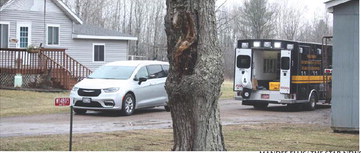WISCONSIN WATCH: Maple syrup producers adapt to warm winter, uncertainty with climate
By Bennet Goldstein, Wisconsin Watch and Brittney J. Miller, Cedar Rapids Gazette The art of maple syrup production flows through generations of Dan Potter’s family history.
His great-grandfather bought the family farm in rural Iowa in the late 1880s and cleared the land for strawberries, clay and whiskey production. Eventually, he transitioned to making maple syrup to add to his whiskey. That started a 140-year-old tradition that has persisted through the Civil War, the Great Depression and both World Wars.
Potter opened his own maple syrup company with his wife and three daughters in 2009. Great River Maple, in Garnavillo, Iowa, is now among the state’s most prolific syrup producers.
This year’s record warm winter caused sap to flow early, bringing challenges for the family-run company. They tapped their first trees on Jan. 22 — more than three weeks earlier than ever before.
“When you take into account that the average season is somewhere around sixand- a-half weeks long,” Potter said, “you’re talking an incredible amount earlier.”
This year’s maple sap season began early in Upper Midwestern states for many producers, who experienced shorter seasons. Some credit those shifts to the year’s record warm winter. Thanks to the El Niño effect, the season ranked among the top 10 warmest.
But Indigenous and non-Native experts say human-caused climate change also is having varied and unpredictable effects on the maple harvest. Farmers and Indigenous communities whose ancestors have tapped trees since time immemorial are altering their practices and planning for an erratic future.
“It seems like from year to year, the season gets a little bit earlier,” said Theresa Baroun, executive director of the Wisconsin Maple Syrup Producers Association. “But nothing, nothing, nothing like this year. If you talk to many older producers, they’ve never seen anything like this as well. This is just a different, weird year here in Wisconsin.”
Climate effects Even amid increasingly earlier seasons, this year stood out, said Justin Cain, operations manager of Maple Valley Cooperative, of Cashton, Wisconsin, whose members include more than 40 farmers from Wisconsin, Michigan, New York and Vermont.
“Most of my farmers were kind of scrambling to get all their taps in and get their vacuums set up,” he said. “Typically, you don’t even think about that stuff till the end of February.”
As of mid-March, cooperative president and maple farmer Cecil Wright and his two business partners had collected about 90% of a normal crop — about 100,000 gallons of maple sap. Wright boiled his first barrel of syrup in early February, about three weeks sooner than normal.
“The weather patterns that we’re seeing are typical for the maple-producing areas in more southern areas like Ohio, Pennsylvania, Indiana,” Wright said.
In Cedar Rapids, Iowa, Indian Creek Nature Center tapped its first maple the second week of February, when temperatures already surpassed 40 degrees. The sap flowed. By March 1, though, the taps trickled to a stop. The season was already over — a month earlier than 2023.
Last year, the center collected nearly 2,000 gallons of sap and produced 46 gallons of syrup, one of its best years on record. This year, it collected 500 gallons, just enough to produce 12.
Sap production depends on temperature and microclimates, where just a few degrees difference can make or break a harvest. Flow depends upon freeze-thaw cycles, which generate the pressure to push the liquid up and down the trunk of the maple. As daylight increases and if the weather warms too quickly, tree buds open, ending the season.
“We’re all limited to what nature gives us,” Cain said. “The trees kind of do their own thing.”
New England and the Midwest dominate maple syrup production in the United States. Wisconsin — the fourth-largest producer in the country — netted about
Please see Maple syrup, page 5



